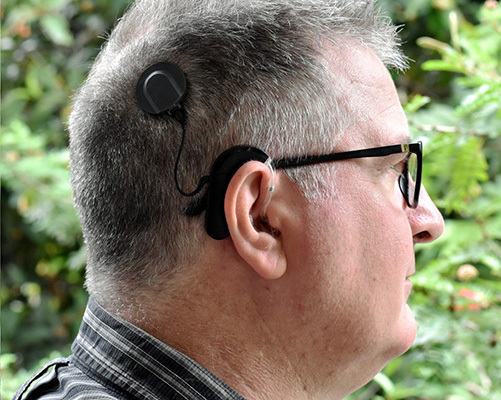
How does a cochlear implant work? It uses a microphone to turn sound into electrical signals that are transmitted directly to the cochlear nerve, bypassing the non-working part of the ear.
Ears work by turning sound waves into electrical signals. The outer ear is shaped like a dish so that it directs sound waves into the ear canal where they strike the eardrum. The vibrations from the eardrum make the three tiny bones (hammer, anvil, and stirrup) vibrate and they amplify the eardrum’s vibrations. The amplified sound waves travel into the cochlea, which is shaped like a snail shell. The cochlea is filled with a fluid that picks up the vibrations as they enter and about 16,000 tiny hairs. The vibrations make the fluid move, which make the hairs move. Nerves in the hairs pick up the movements, translate them into an electrical signal, and send that signal along the cochlear nerve to the brain. The hairs that pick up high frequency sound are at the front of the cochlea and the ones that pick up low frequencies are at the back. The ones at the front get damaged first, which is why most people lose their ability to hear high-pitched sounds first.
There are many reasons why someone may become deaf. Some people are born deaf. A genetic problem can cause the ear not to function properly. Some people can become deaf due to a loud noise or sudden high pressure. The eardrum is a very sensitive, thin piece of tissue. It has skin on one side and a mucous layer on the other. A sudden very loud noise, or a sudden burst of high-pressure air can rupture the eardrum. An eardrum can heal, but not always and no eardrum makes it very difficult to hear. Sounds will be muffled. The biggest reason most people lose their hearing is exposure to loud noises. The hairs in the cochlea are very sensitive. If they are exposed to very loud noises for a long time, they will die. When we experience a loud noise, the hair cells bend over. If you go to a loud concert, you cannot hear properly for a few hours after because the hair cells are still bent over and cannot pick up sounds. After a few hours, the hairs straighten up and you can hear properly again. The eardrum may be able to heal itself because it is skin, but these nerve cells cannot heal themselves. Once they are gone, they are gone. It is possible to lose up to 50% of the hairs before you start to notice problems with your hearing. If the damage continues after this level, hearing ability will gradually decrease.
People who have lost a significant amount of their hearing can be helped with hearing aids. A hearing aid basically amplifies the sound waves so that the damaged hairs in the cochlea can pick them up. It has a microphone that picks up sounds, an amplifier, and a speaker that is inserted into the ear. Hearing aids can only work if there are still enough hairs left alive in the cochlea.
So, what is a cochlear implant and how does it work? The principle is that technology is used to bypass the damaged cochlea. A microphone is placed just above the ear. The microphone is connected to a speech processor. These are worn over the ear with a battery. The earpiece has a transmitting coil with a magnet that connects to the head. A magnetic receiver is placed on the skull, under the skin, through surgery. The signals picked up by the external device are transmitted to the receiver. The receiver converts these signals into electric pulses. The receiver sends these electrical pulses to electrodes that have been implanted inside the cochlea and connected to the cochlear nerve. The cochlear nerve carries these signals to the brain and they are processed in the temporal lobe, the part of the brain responsible for processing sound.
It takes about 6 months to learn how to understand the sounds that are sent to the brain because they are not the same as the sounds a hearing person hears. A person who was born deaf would probably adapt to a cochlear implant more quickly than someone who lost their hearing, because they have no preexisting knowledge of what sound should sound like. A cochlear implant doesn’t produce sound in the way that a normal ear would hear, but it can be enough to understand conversation.
Cochlear implants have come a long way from when they were invented in 1957. In the relatively near future, it may be possible to make electrodes that connect to the nerves more naturally, and the connectivity between the external and internal devices will improve. Artificial Intelligence in the speech processor may also be able to recreate sounds more naturally. However, being able to completely and perfectly fix complete hearing loss is still a long way off. And this is what I learned today.
Sources
https://www.hopkinsmedicine.org/health/conditions-and-diseases/how-the-ear-works
http://hyperphysics.phy-astr.gsu.edu/hbase/Sound/oss.html
https://www.mayoclinic.org/diseases-conditions/hearing-loss/symptoms-causes/syc-20373072
https://www.cdc.gov/nceh/hearing_loss/how_does_loud_noise_cause_hearing_loss.html
https://www.hopkinsmedicine.org/health/conditions-and-diseases/hearing-loss/how-do-hearing-aids-work
https://www.babyhearing.org/devices/how-does-a-cochlear-implant-work
https://www.nidcd.nih.gov/health/cochlear-implants
https://www.mayoclinic.org/tests-procedures/cochlear-implants/about/pac-20385021
